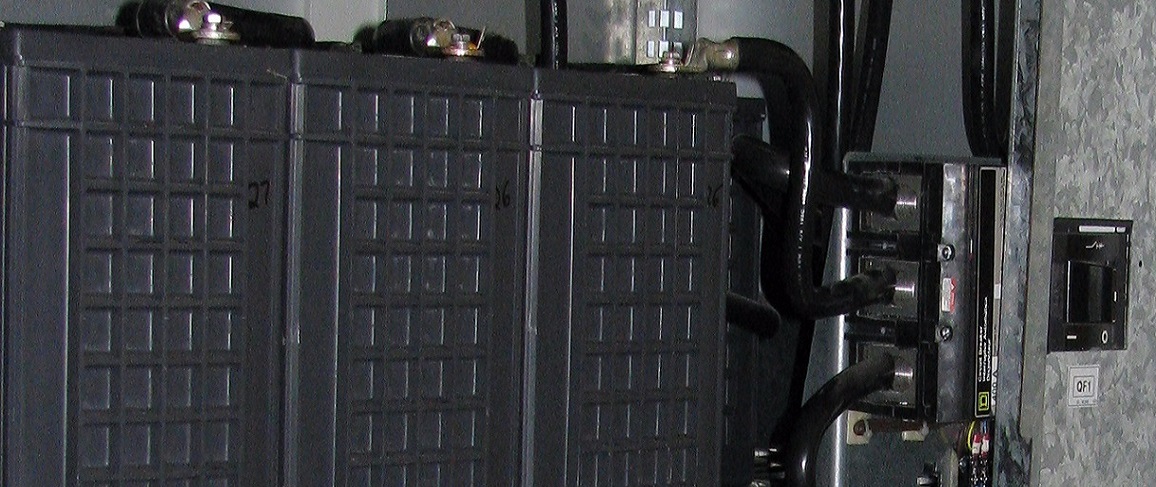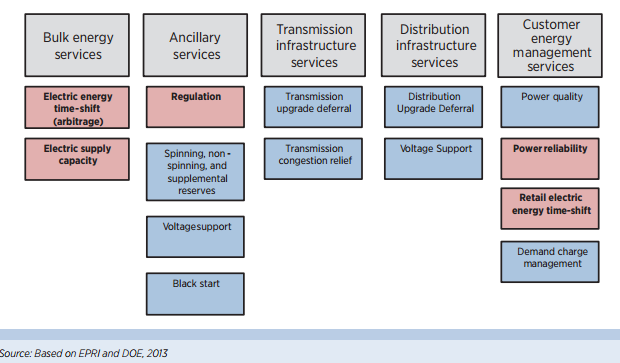A version of this article was originally published on June 29, 2015 on Greentech Media.

By Michael O’Boyle and Sonia Aggarwal
Price declines in residential solar and new battery systems like Tesla’s Powerwall are likely to mean more solar-plus-battery systems at homes and businesses around the country. For now, other resources like efficiency, demand response, and rooftop solar are cheaper than storage, but storage has been riding an 80 percent price decline for the past five years, so things might shift around faster than people expect. Like these other distributed energy resources (DERs), customer-owned distributed storage puts competitive pressure on utilities by reducing customers’ reliance on the grid. As costs of all these resources come down, customers can afford to rely less and less on the grid for electricity service. This phenomenon, coined “load defection” by smart folks at the Rocky Mountain Institute, is antithetical to traditional utility business models where increased electricity sales drive revenue growth.
Some load defection is not necessarily a bad thing, however, as long as it does not progress to full grid disconnection. Ideally, electricity system operators would be indifferent as to which types of resources¬—distributed, centralized, or grid infrastructure—meet system needs and policy goals. Distributed and centralized resources should compete to serve customers. Storage should be deployed in the location and the scale that can maximize its value for the electricity system. This kind of system optimization necessitates a certain degree of load defection—or at least load evolution.
Much worse than these kinds of changes in load dynamics would be a future in which a large number of customers disconnect from the grid entirely. This would be a raw deal for utilities and consumers as a whole. A collection of uncoordinated pockets would sacrifice the benefits of resource sharing, resulting in an unnecessarily expensive and inequitable electricity system.
To avoid this future, it is in the long-term interest of the system operator (or the distribution utility at the local scale) to support optimized deployment of distributed energy resources, including storage. One option is for incumbent utilities to own and operate some distributed resources. Australian utilities are moving in this direction. On the one hand, utility ownership could facilitate an even bigger market for these technologies in the most valuable locations, allowing the benefits to be shared by all customers. On the other hand, utility ownership could undermine competition and innovation.
The Role of Battery Storage
Distributed battery storage is extremely versatile. Storage can act like everything at once: generation, distribution infrastructure, load, and demand response. Some of those functions (like distribution infrastructure) fall clearly under the distribution utility’s “natural monopoly” franchise. However, many of the other services have long been successfully subjected to competition without adverse effects. This is what distinguishes distributed storage from other DERs. This versatility of storage makes the propriety of utility ownership a particularly murky question.
Battery storage is still pretty expensive, and today, system operators are quite capable of providing needed grid flexibility with cheaper resources (e.g., demand response) and distribution upgrades. But as the grid gets cleaner and more modern, the value of flexibility will increase, and thus storage will have a greater value potential. Assuming the markets are set up to be able to pay for the full range of valuable flexibility services, battery storage will begin to compete in more and more applications:
Figure – Services Provided by Battery Storage

Source: IRENA Battery Storage for Renewables: Market Status and Technology Outlook 2015
In the absence of a real-time market at the distribution level, a distribution utility is in a good position to see across the full fleet of resources and be able to identify higher value locations and times for certain services. Customers (and DER aggregators) respond to the rate structure, and will act to optimize the system only if they are properly compensated. Under common rate structures, customers are more likely to operate storage to maximize its on-site benefits, rather than to optimize the grid. Moreover, customer-sited storage that behaves unpredictably may even require distribution system upgrades, like rooftop solar has in some high-penetration areas. By contrast, distribution utilities, armed with knowledge of the scale, timing, and location of energy, ancillary service, and future capacity needs, could maximize the short- and long-term value of distributed storage through operational changes and rate reform.
Pros of Utility-Owned Storage
A utility can integrate storage into long-term system-wide planning, and can determine the most valuable way to operate storage in real-time alongside other resources. If allowed to own storage as costs continue to come down, utilities would have a versatile new tool to help optimize the distribution system, increasing flexibility and enabling the integration of other cost-effective customer-sited resources. Because utilities can look across all resources to determine the lowest-cost way to maintain reliability, they are in a good position to take advantage of the fact that storage can act like generation, transmission, load, or demand response, depending on what’s most valuable at the time.
Economies of scale also apply to the operation and installation of distributed battery storage. The cost of storage may drop with larger or simultaneous installation projects. But even more important: storage owned and operated by the utility could operate in concert with other distribution infrastructure or other storage units. Fleets of distributed storage owned by the utility could be deployed and operated as an integrated part of the distribution infrastructure portfolio. As a result, a utility-owned storage project may be the cheapest option to meet system needs even if opened up to a competitive bidding process.
Finally, utility ownership of distributed storage may also better support access for low-income customers. Customers who otherwise lack the finances to buy a distributed storage unit would be able to access the grid-wide benefits of storage through the utility.
Cons of Utility-Owned Storage
Utility ownership of distributed storage raises some market power concerns—it could stifle innovation and growth in storage deployment in three main ways. First, the utility may use ratepayer funds to install storage in one area, diluting the grid value of customer-sited storage investments in that area and crediting customers less as a result. Second, distribution utilities have direct access to customers and—in some areas—major branding advantages over third party installers. This presents barriers to entry, and thus innovation, for private companies; it even raises the possibility of market manipulation to crowd out competition.
Third, utilities have a theoretical ability to use storage as a tool to optimize the distribution system, but their motivation may be otherwise. System optimization of this kind is not necessarily rewarded under traditional cost-of-service regulation; in fact, under most models, utilities have financial incentives to make larger investments as long as they meet “used and useful” tests for prudency. In other words, higher capital expenditures drive higher profits. Considering storage is still a relatively expensive option for grid flexibility, utilities should have a high bar to meet. Customers, on the other hand, have direct incentives to save on energy bills. If given the right rate structure, innovative customers and energy management companies could even optimize the use of storage from the grid’s perspective. Of course, many recent innovations in electricity service have been driven by companies eager to compete with incumbent utilities.
Case in Point: New York’s Take on Utility Ownership of Distributed Storage
New regulatory models can help capture the pros of utility ownership while limiting the cons described above. New York’s Reforming the Energy Vision (REV) provides an example of rules attempting to limit utility market power while still incenting optimal distributed storage deployment.
The REV is fundamentally changing the utility business model by requiring utilities to create and operate a market or “platform” for distributed energy resources. Many hope that this market development will drive system optimization by making distribution utilities neutral about which resources provide grid services, optimizing the performance of distributed assets and animating markets for customer-sited resources.
In the first order adopted under REV, New York decided to disallow utilities from owning most distributed energy resources, stating that market power concerns outweigh most benefits of utility ownership. The PSC cites three concerns: conflict with the REV’s purpose of animating private investment (supported by proven interest from third-party installers), branding advantages for the incumbent utility and the appearance of impropriety, and conflicts with the platform management function of the utility. However, acknowledging the potential for storage, the REV does allow utilities to own and operate distributed storage under limited conditions, illustrating storage’s unique role. New York’s regulators decided to allow utility ownership of storage in the distribution system, but not behind the customer’s meter.
Essentially, New York’s regulators allow some dilution of value for customer-sited storage in exchange for more optimally-located storage deployment. By prohibiting ownership of customer-sited storage, however, the utility will not compete with innovative third parties that want to install and even operate storage systems for individual customers. These changes in New York are accompanied by performance-based regulation, which aims to incent utilities to make optimal choices about resource deployment on the distribution system.
Recommendations for Policymakers
-
- 1. Refine the rate structure to incentivize
- of customer-sited storage. Move towards more granular rates that reward grid services for sophisticated customers.
Customers will respond to electricity rate design when making choices about whether to invest in storage. Time-invariant rates do not allow customers to get paid for providing grid services. Opt-in rates that better align with modern, dynamic grid systems (like time-varying rates) can allow sophisticated customers and third-party aggregators to maximize the value of their own storage, provide grid services, and stay connected.
- 2. Use pilot programs to let utilities experiment with incenting and operating distributed storage in the most valuable locations on the grid.
Utilities should be allowed to own storage for demonstration purposes, to assess the full range of possibilities for this new technology. Utilities can also set up incentive programs for customers to install and own storage, with a default to (override-able) utility operation (e.g. Southern California Edison’s storage procurement filing from 2014). More experimentation can lead to a better understanding of how to optimally deploy storage.
- 3. Encourage utilities to share aggregated data on locations in the distribution system where storage would be most valuable.
One advantage utilities bring to storage deployment is their unique knowledge of system needs. With access to better information (as long as it’s sufficiently aggregated so as to protect privacy), companies can more effectively compete to fill system need, reducing the need for utility investment.
- 4. Break the link between volumetric sales and utility profits; ensure that the utility is indifferent to investing in distributed, centralized, or grid infrastructure, as long as demand for grid services are met at least cost and policy goals are achieved.
Utilities should have incentives to optimize the system and support cost-effective deployment of distributed storage as part of the resource portfolio. Regulators should consider metrics and incentives for storage operation and performance such as reduced system load factor, avoided distribution upgrades, better power quality, and low-income development.
While the calculus may be different for other distributed energy resources like rooftop solar, battery storage presents a unique set of concerns for utility regulators. Allowing utility ownership—with smart constraints—can unlock the potential of storage, offering new revenue streams to utilities and third parties while protecting against market power concerns. New regulatory models will be required to strike the right balance, ensuring that customers remain connected and the utility “death spiral” never materializes.
